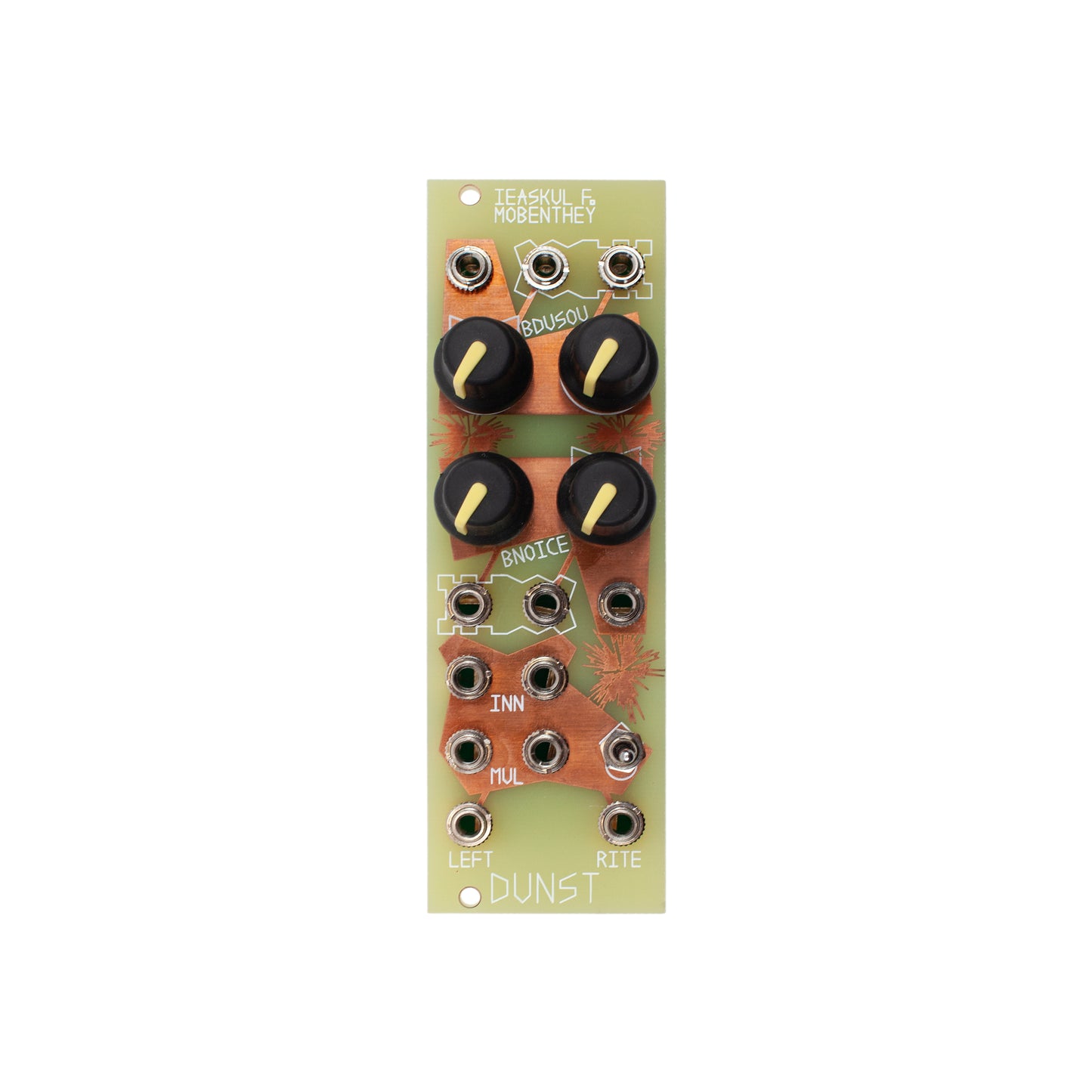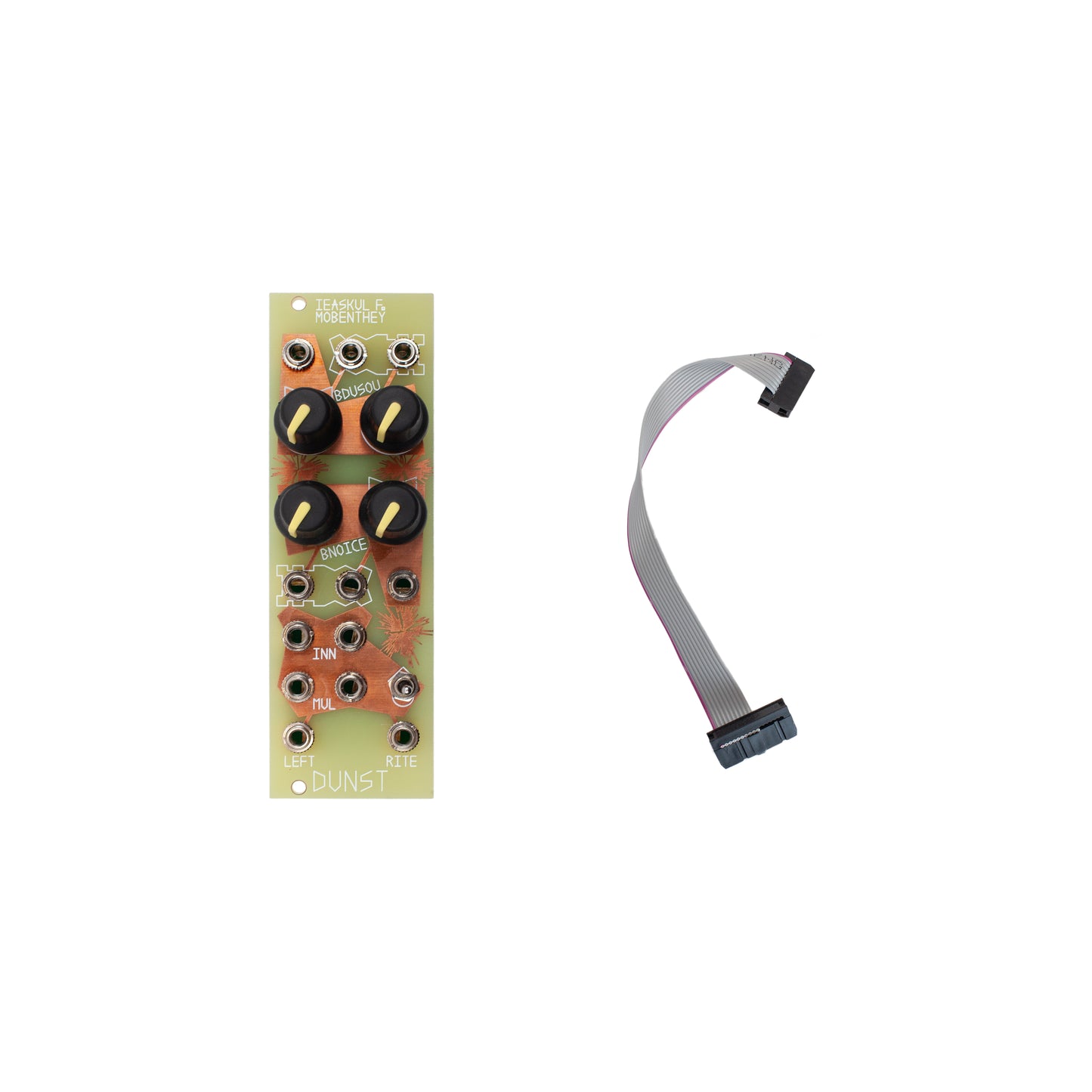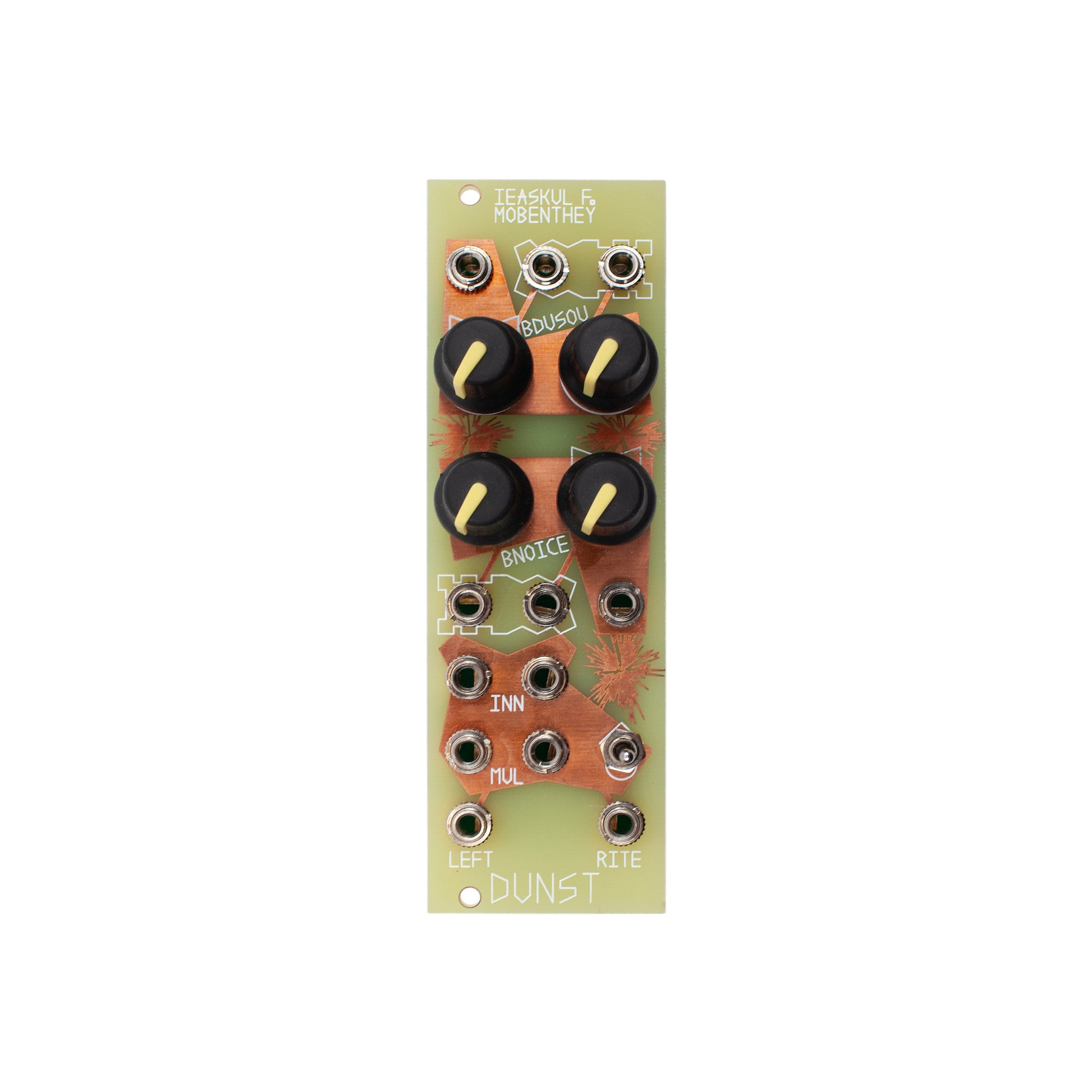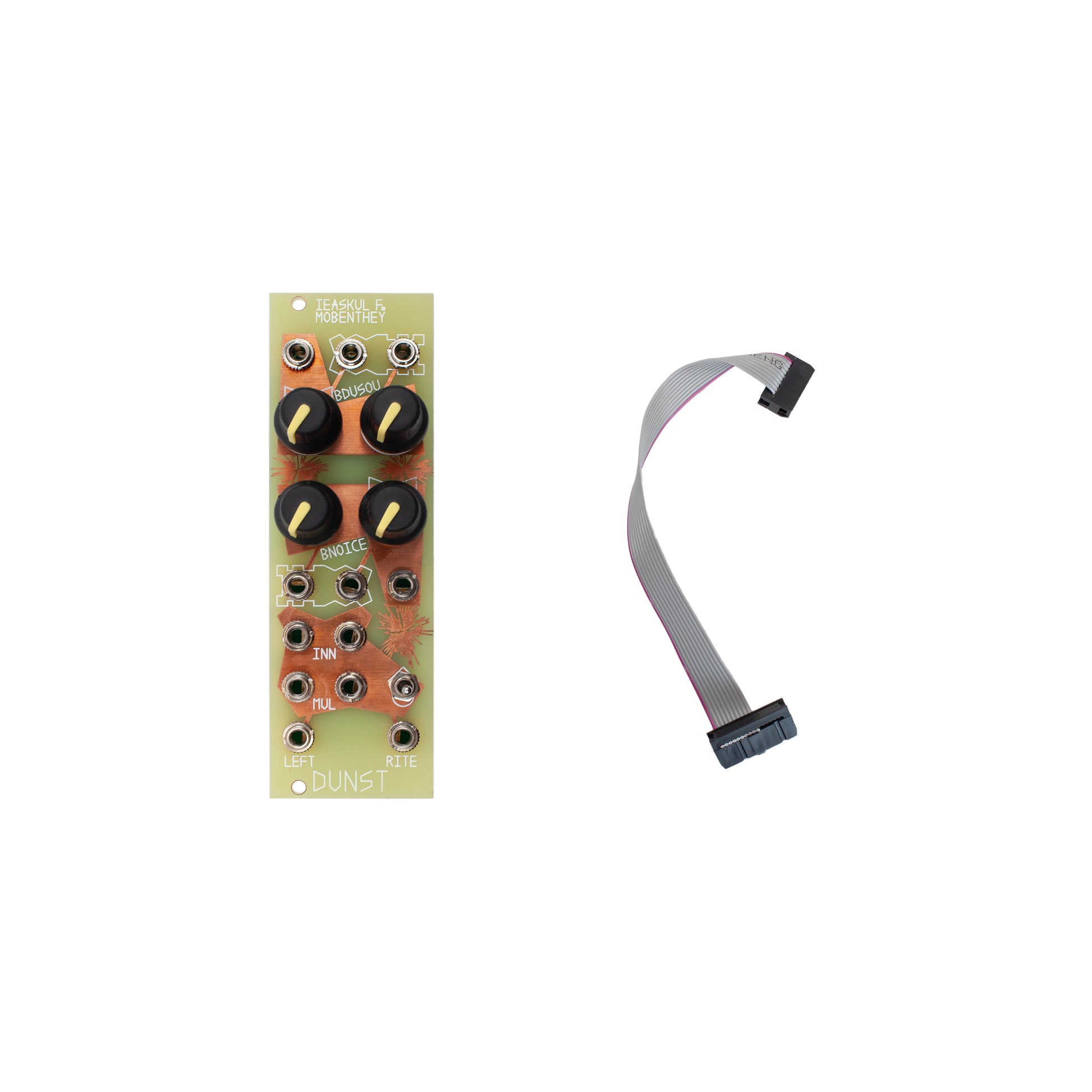Ieaskul F. Mobenthey
Dunst
Dunst
受取状況を読み込めませんでした
Eurorack format from Ciat-Lonbarde
In Stock
Dunst: generate bursts and triggers in a random distribution and is a perfect dual noise generator with a stereo VCA with inputs accepting normal eurorack inputs and low impedance things like contact mics, and instruments. Is this Magic?
Text by Peter Blasser:
The Dunst module generates Dust and Noise by two different methods. Noise is defined as white noise, with an continuous spectrum and a totally non-tonal nature. Dust, however, is better thought of outside Fourier techniques, as little crackles, bursts of noise, pulses of uneven rhythm. Dunst permutes on the bounds/bounce concepts of other Mobenthey modules, by calculating Dust with a ramp with arbitrary sample-and-hold for its bounds- based on an efficient digital technique for Dust. The Noise section uses transistor noise (quantum) as its basis, comparing it against a modular reference to achieve stochastic events, converging on the sound of Dust. In addition, this module has a fully featured bi-polar VCA with complimentary inputs, to get you quickly going sending “dust-objets” out the left and right channels.
Dunst is an 8HP Eurorack module that runs on +12 and -12 volts. Attach power connector positive to “+” and negative to “-”.
Looking at the front panel of Denum, note that inputs are marked by copper fill. There are three main sections: BDUSOU, BNOICE, and the VCA. BDUSOU is the analog dust calculator, and BNOICE is the quantum sourced generator. Each of the two has exactly the same inputs, outputs and knobs. The “basis” knob sets the base rate of dust, from sparse to dense. The FM control input is tied to an attenuverter, marked by a characteristic bow-tie. An attenuverter works like this: at noon the modulations are nulled out, they have no effect; clockwise from there they increase in intensity, with positive input meaning “more”; to the counter- clockwise direction, modulations increase as well, but with negative input meaning “more”. This knob is essential to controlling how much, and in which direction, your modulations apply.
BDUSOU has two outputs: a ramp, and a pulse. Ramp, marked by triangular articulations on the cartouche, is the actual waveform used to generate Dust. It looks like a sawtooth, with completely random bounds. Pulse, marked by rectilinear articulations, speaks to the zero-crossing “tooth” of Dust, with a short pulse from zero to ten volts.
BNOICE has two outputs: pulse and hiss. Pulse is similar to the pulse of BDUSOU: a brief spike from zero to ten volts, with varying densities. Hiss, is the raw quantum-sourced white noise. Hiss is bussed into the left and right audio inputs of the VCA, at bottom. Either can be swapped out for external audio energies, via the “left, right signal inserts”. The “left, right VCA inputs” are for controlling the amplitude of the signals, with either a linear or exponential mapping. If the left input is greater than right, sound goes out the “left out”. If right is greater than left, sound goes out the “right out”. The voltage amount of difference maps to loudness in these channels. The “linear, expo switch” chooses linear when cocked up, as marked by a caret, and exponential when cocked down, as marked by a rounded form. There is an optional mute when the switch is in the middle.
BDUSOU/BNOICE
Why are the modules called that? This module flirts with BOUNDS/BOUNCE, so I rearranged this text, until it suggested DUST and NOISE. BDUSOU uses contingent boundaries, both negative and positive, for its sawtooth, to calculate dust with a stochastic distribution of bursts, flirts, and spaces. What is DUST, if you asked James McCartney, in his computer music program, Supercollider? It's a sort of random, but with particles, so how do you know it's vanilla-chaos or hyper-chaos? How many powers of random do you want? It could be bursts of completely harsh noise followed by minutes of silence. This module, however, does not follow the extreme path; instead it follows the middle road, set forth by McCartney, of a usable timing pulse for random, rain-like events. By modulating BOUNDS, it does not go into the hyper-chaos available with BOUNCE generators. That is left to its FM input, which strictly modulates its bounce, or slope speed.
On completing the first run of Mobenthey modules, I initiated prototyping this fifth module. It is a new thrust on this platform and also in Tocante to bring forth various assets of zener noise that I have explored in my oldest instruments, such as Nabra. That synthesizer contained a Dust module, which simply generates trigger pulses at random intervals below the haptic rate. Nabra also contained a Noise module, which acted as an audio generator with VCA inputs. It also took control voltages as a modulation for crackle; its sound could change from smooth white noise to something more like a dusty record.
Dust and Noise operate in two compellingly different manners. Dust “computes” its randomness by sampling a stochastic waveform to mark an arbitrary voltage, then decays to zero to repeat again. Noting that this is an arbitrary bounds modulation, the bounce of the module is free for control by input voltage, thus varying the speed or concentration of dust particles. This circuit is a variation bounds-bounce regime established in the previous modules.
Unlike Dust, Noise uses a zener diode or other suitably noisy silicon source, amplifying the natural noise of indecisive electrons. It modulates crackle by a comparison of that noise and an arbitrary input voltage; near zero, it is pure noise, but crossings of a farther bias voltage become more event-like, approaching the sound of Dust.
Since both circuits achieve different flavors of the same basic goal, I decided to combine them into a single module. The name is simply an amalgam- Dust with Noise makes Dunst. The next step is checking a name on Google. Finding, of course, Kirsten Dunst as the primary placeholder, I also see the German definition of the word is a sort of haze or fog; a good omen.
So that is the current state of Mobenthey, having completed a run, I add a new and dusty module, tied into the previous modules by the bounds-bounce concept. The new module breaks from the previous modules by focusing on stochastic dust instead of modulated waveforms. It demonstrates the paradox wave, Ieaskul's goal, not by infinite regression but by the indeterminate nature of silicon components themselves- noise.




